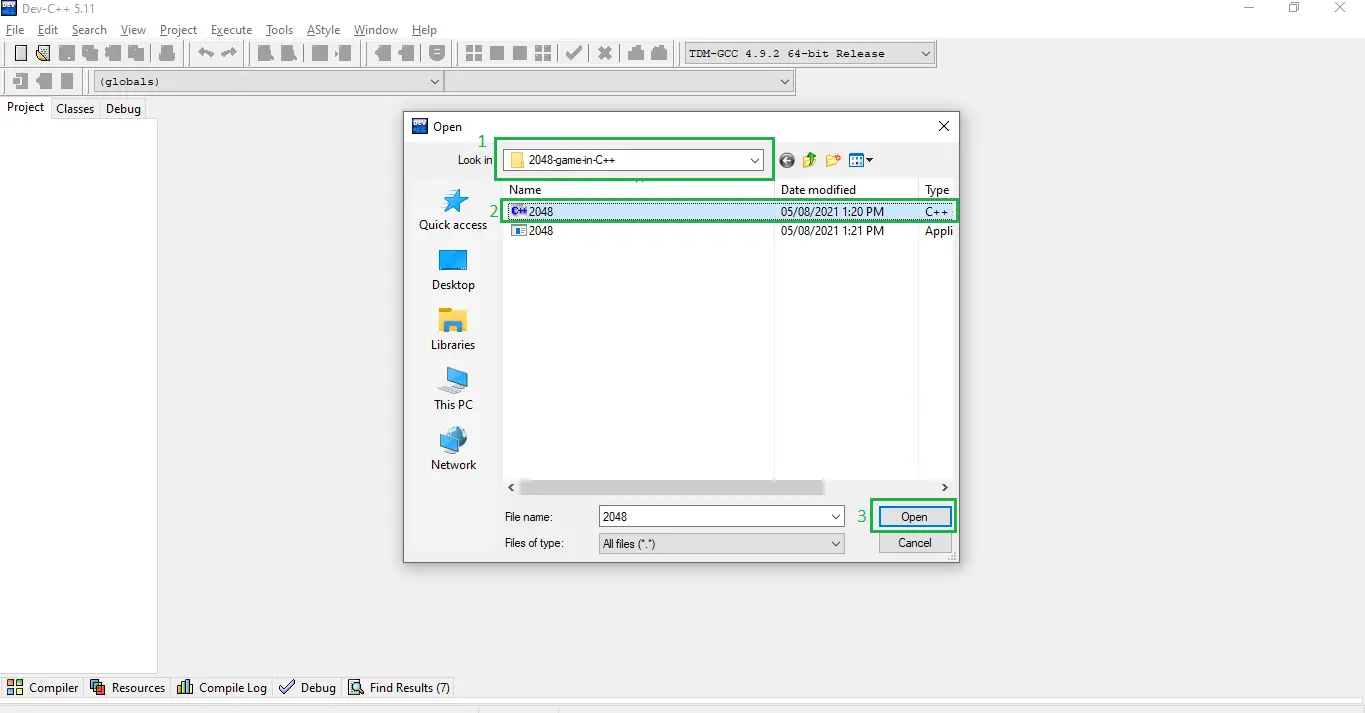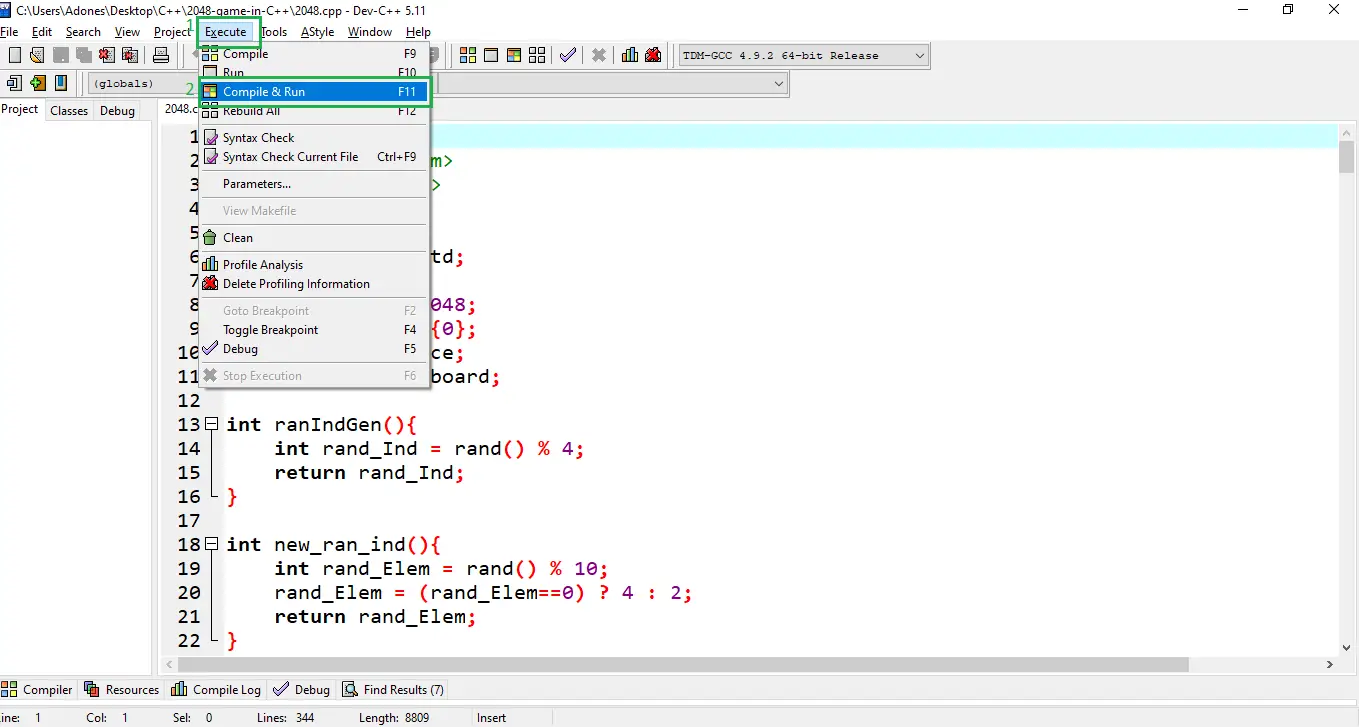Creating a 2048 Game In C++ Language is an excellent method to become acquainted with a new computer using C++ programming language.
The game primarily evaluates the game player’s status based on the two-dimensional array or the player’s activities (press the button a, w, s and d). As a result, employ variables to keep track of the player’s current state.
| ABOUT PROJECT | PROJECT DETAILS |
|---|---|
| Project Name : | 2048 Game |
| Project Platform : | C/C++ |
| Programming Language Used: | C++ Programming Language |
| Developer Name : | itsourcecode.com |
| IDE Tool (Recommended): | Dev-C++/Codeblocks |
| Project Type : | Desktop Application |
| Database: | Stores data in .DAT file |
The key value created by pressing the key and the outcome of the two-dimensional digital square matrix are the most important aspects of the event. To preserve the final two-dimensional data, use a two-dimensional array.
The Project’s Planning
It’s a good idea to plan ahead of time before beginning any program. Although our software is simple, it nonetheless necessitates the use of various components.
First, Create two random digital objects on this “square matrix,” then use the up, down, left, and right buttons to combine them. As a result, digital features are two-dimensional and discrete.
Finally, By reading and writing files, I’m here to finish the display and recording of the player’s previous scores. If a pair of numbers is correctly joined with each directional movement, 4 points will be added.
The current player score is presented in real time as the current score during the graphical interface refresh, and the score of the read file is the highest in history.
Importing Libraries
The first step is to determine which C++ libraries are required for our program to run. These will be at the beginning of the presentation.
Import a library’s header files with #include. Iostream is the first library that our software requires. We’ll use this library to manage our guessing game’s basic input and output.
What is a C++ library?
A C++ library contains code that can be used in a variety of projects. A library usually contains methods and classes that deal with a generic procedure that many developers are likely to use. C++, for example, includes libraries for processing input and output, which is a common task in many programs.
To run this 2048 Game In C++ Free Download make sure that you have a Code Blocks, DEV C++ or any platform of C++ installed in your computer.
2048 Game Code In C++ Source Code Steps On How To Run The Project
Time needed: 5 minutes
Here’s the step’s on how to run a 2048 Game In C++ Source Code.
- Step 1: Extract file.
Then, after you finished download the source code, extract the zip file.

- Step 2: Open Code Blocks or Dev C++
Next, After extracting the zip file, open your “Code Blocks IDE” or “Dev C++”.

- Step 3: Open Project.
After that, open file tab and Open File after that open folder 2048-game-in-C++ click the “2048“.

- Step 5: Run Project
Lastly, Click execute tab and select compile & run or you can use the shortcut key F11.

- Step 6: The actual code.
Finally, You are free to copy the given source code below or download the downloadable source code given.
Downloadable Source Code
Summary
In summary, create a class Game 2048 Game Code In C++ to describe the game, and use the variables status and two-dimensional array data to represent the game’s attributes.
Finally, create class methods to represent the game’s actions, such as related methods for drawing the graphical interface, restart initialization method, up and down, and so on. Determine how the game will end by moving left and right. The list consists of the characters srand unsigned, the arrow key, 0 for int, and time null.
Related Articles
Inquiries
If you have any questions or suggestions about 2048 Game In C++ With Source Code, please feel free to leave a comment below.






What the password of ZIP file?
Zip file password: itsourcecode.com or itsourcecode
int index_ado, index_john, index_jude, index_jenny;
what are these used for? ^
Its only for variable name, you can change it the variables.
was going through the code and got a little confused at the functions controlling the directions.
can you please explain what the following section of code does?
for (int i = 0; i < 4; i++)
{
for (int j = 0; j < 4; j++) // runs the loop for each column 3 times
{
for (int k = 0; k < 3; k++)
{
if (board[i][k] == 0 && board[i][k + 1] != 0) //why XOR why not &?
{
//^ is binary XOR operator will give 1 if the 2 values are mismatched!
board[i][k] = board[i][k] ^ board[i][k + 1]; //if both same gives 1
board[i][k + 1] = board[i][k] ^ board[i][k + 1];
board[i][k] = board[i][k] ^ board[i][k + 1];
flag++;
}
}
}
}
if (flag != 0)
{
adding_element();
sequence++;
}
display();